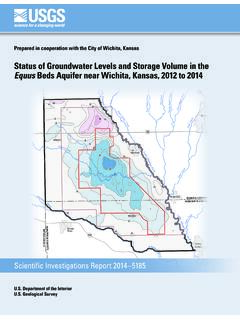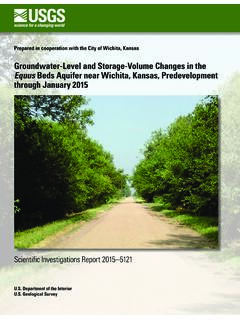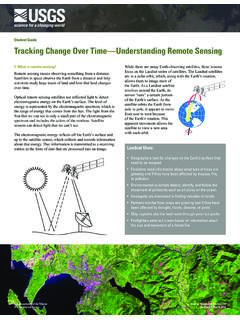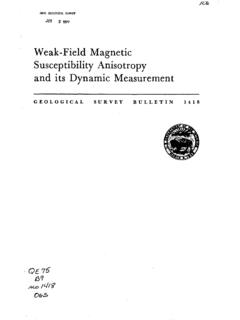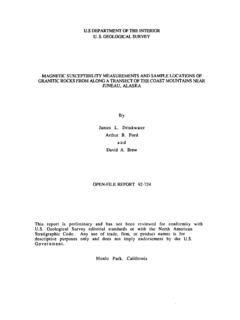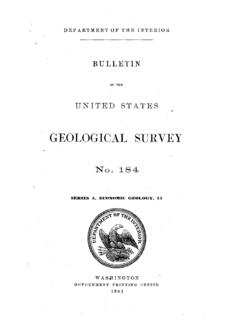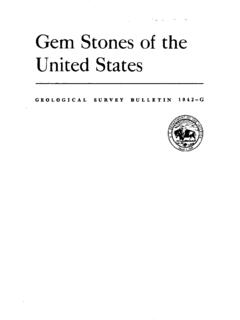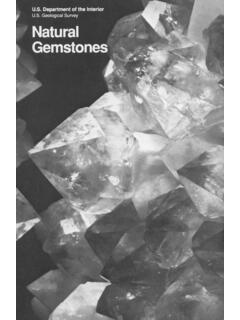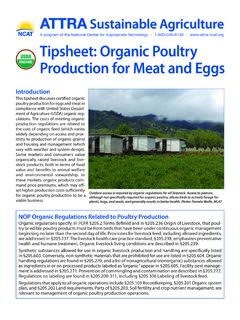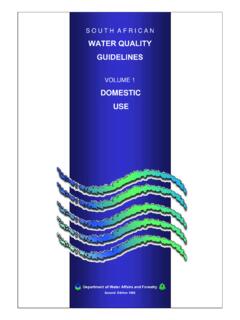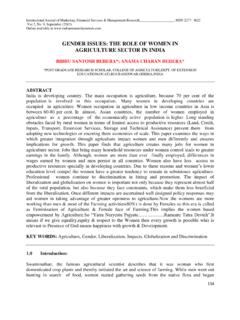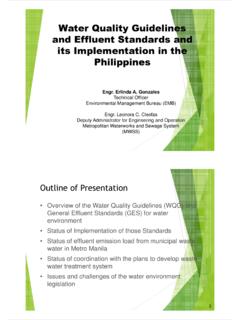Transcription of Estimated Use of Water in the United States in 2005 - USGS
1 Department of the Geological SurveyCircular 1344 Estimated Use of Water in the United States in 2005 1 Chemical manufacturing plant. Photo used with permission. 2 Sand and gravel mine, Texas. Photo by Nancy L. Barber, USGS. 3 Domestic Water use. Photo by Nancy L. Barber, USGS. 4 Fire hydrant. Photo by Peter Griffin, 5 Upper Mississippi River, Wisconsin. Photo by Bob Nichols, USDA Natural Resources Conservation Service. 6 livestock watering tank. Photo courtesy of USDA Natural Resources Conservation Service. 7 Domestic Water use. Photo by Nancy L. Barber, USGS. 8 Alaska salmon. Photo courtesy of Fish and Wildlife Service. 9 Center pivot irrigation system.
2 Photo by Tim McCabe, USDA Natural Resources Conservation Service. 10 Water tower. Photo by Nancy L. Barber, USGS. 11 Oil well, New Mexico. Photo by Alan M. Cressler, USGS. 12 Holstein dairy cows. Photo by Bob Nichols, USDA Natural Resources Conservation Service. 13 Flowing well in the Floridan aquifer, Brunswick, Georgia. Photo Alan M. Cressler, USGS. 14 Catfish ponds, Louisiana. Photo by Scott Bauer, USDA Agricultural Research Service. 15 NIPSCO Coal Power Plant cooling tower. Photo by John J. Mosesso, USGS National Biological Information Infrastructure. 16 Cranberry harvest, New Jersey. Photo by Keith Weller, USDA Agricultural Research Service.
3 17 Horseshoe Falls, Niagara River. Photo by Alan M. Cressler, USGS. 18 Domestic Water use. Photo by Nancy L. Barber, USGS. 19 Breeder chickens in Cleburne County, Alabama. Photo by Michael J. Harper, Alabama Office of Water Resources. 20 Drip irrigation on citrus. Photo by Ron Nichols, USDA Natural Resources Conservation Photo collage of Water use and Use of Water in the United States in 2005By Joan F. Kenny, Nancy L. Barber, Susan S. Hutson, Kristin S. Linsey, John K. Lovelace, and Molly A. Maupin Circular Department of the Geological Department of the InteriorKEN SALAZAR, Geological SurveySuzette M. Kimball, Acting Geological Survey, Reston, Virginia.
4 2009 For more information on the USGS the Federal source for science about the Earth, its natural and living resources, natural hazards, and the environment, visit or call 1-888-ASK-USGSFor an overview of USGS information products, including maps, imagery, and publications, visit order this and other USGS information products, visit use of trade, product, or firm names is for descriptive purposes only and does not imply endorsement by the this report is in the public domain, permission must be secured from the individual copyright owners to reproduce any copyrighted materials contained within this citation:Kenny, , Barber, , Hutson, , Linsey, , Lovelace, , and Maupin, , 2009, Estimated use of Water in the United States in 2005: Geological Survey Circular 1344, 52 of Congress Cataloging-in-Publication DataEstimated use of Water in the United States in 2005 / by Joan F.
5 Kenny ..[et al.]. -- 1st ed. p. cm. -- (Circular ; 1344) Includes bibliographical references. ISBN 978-1-4113-2600-2 1. Water consumption-- United States . I. Kenny, J. F. II. GeologicalSurvey ( ) III. Series: Geological Survey circular ; 1344. 2009 130973090511--dc22 2009041893iiiContentsAbstract .. and Scope ..2 Terminology ..2 Changes for the 2005 Report ..3 Sources of Data and Methods of Analysis ..3 Acknowledgments ..3 Total Water Use ..4 Public Supply ..35 Thermoelectric Power ..38 Trends in Water Use, 1950 2005 ..42 References ..47 Cooperating Agencies and Organizations.
6 50ivConversion FactorsMultiplyByTo obtainAreaacre4,047square meter (m2) (ha) mile (mi2)Volumeacre-foot (acre-ft) 1,233cubic meter (m3)acre-foot (acre-ft)325,851gallons (gal)acre-foot (acre-ft)43,450cubic feet (ft3)cubic foot (ft3) (gal)gallon (gal) (L) gallon (gal) decimeter (dm3) million gallons (Mgal) 3,785cubic meter (m3)million gallons (Mgal) (acre-ft)Flow rateacre-foot per year (acre-ft/yr) 1,233cubic meter per year (m3/yr)billion gallons per day (Bgal/d) cubic meters per yeargallon per day (gal/d) per day (L/d)million gallons per day (Mgal/d) meter per second (m3/s)million gallons per day (Mgal/d) feet per second (ft3/sec)
7 Million gallons per day (Mgal/d) acre-feet per year (acre-ft/yr)million gallons per day (Mgal/d) cubic meters per yearthousand acre-feet per year (acre-ft/yr) gallons per day (Mgal/d)Energygigawatthour (gWh)3,600,000 Megajoule (MJ)kilowatt-hour (kWh)3,600,000joule (J)Othercubic foot (ft3) (lb)gallon (gal) (lb)gallons per day per square mile [(gal/d)/mi2] meter per day per square kilometer [(m3/d)/km2]inch of rain (in)27,200gallons per acre (gal/ac)Acronyms Used in this ReportSDWIS Safe Drinking Water Information SystemUSDA ARS Department of Agriculture, Agricultural Research ServiceUSDA NASS Department of Agriculture, National Agricultural Statistics ServiceUSDA NRCS Department of Agriculture, Natural Resources Conservation ServiceUSDOE EIA Department of Energy, Energy Information AdministrationUSEPA Environmental Protection AgencyUSGS Geological SurveyEstimated Use of Water in the United States in 2005By Joan F.
8 Kenny, Nancy L. Barber, Susan S. Hutson, Kristin S. Linsey, John K. Lovelace, and Molly A. Maupin AbstractEstimates of Water use in the United States indicate that about 410 billion gallons per day (Bgal/d) were withdrawn in 2005 for all categories summarized in this report. This total is slightly less than the estimate for 2000, and about 5 percent less than total withdrawals in the peak year of 1980. Fresh- Water withdrawals in 2005 were 349 Bgal/d, or 85 percent of the total freshwater and saline- Water withdrawals. Fresh groundwater withdrawals of Bgal/day in 2005 were about 5 percent less than in 2000, and fresh surface- Water withdrawals of 270 Bgal/day were about the same as in 2000.
9 Withdrawals for thermoelectric-power generation and irriga-tion, the two largest uses of Water , have stabilized or decreased since 1980. Withdrawals for public-supply and domestic uses have increased steadily since estimates began. Thermoelectric-power generation Water withdrawals were an Estimated 201 Bgal/d in 2005, about 3 percent more than in 2000. In 2005, thermoelectric freshwater withdrawals accounted for 41 percent of all freshwater withdrawals. Nearly all of the Water withdrawn for thermoelectric power was surface Water used for once-through cooling at power plants. Twenty-nine percent of thermoelectric-power withdrawals were saline Water from oceans and brackish coastal Water for irrigation in 2005 were 128 Bgal/d, about 8 percent less than in 2000 and approximately equal to estimates of irrigation Water use in 1970.
10 In 2005, irriga-tion withdrawals accounted for 37 percent of all freshwater withdrawals and 62 percent of all freshwater withdrawals excluding thermoelectric withdrawals. Irrigated acreage increased from 25 million acres in 1950 to 58 million acres in 1980, then remained fairly constant before increasing in 2000 and 2005 to more than 60 million acres. The number of acres irrigated using sprinkler and microirrigation systems has continued to increase and in 2005 accounted for 56 percent of the total irrigated withdrawals for public supply were Bgal/d in 2005, which is 2 percent more than in 2000, although the population increased by more than 5 percent during that time.
